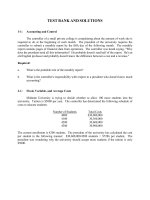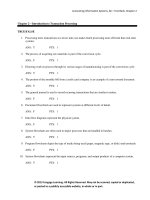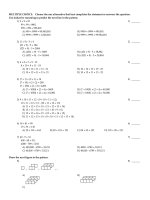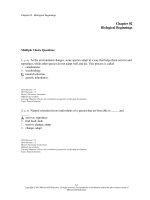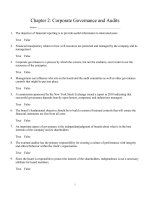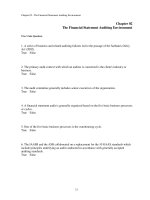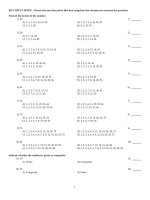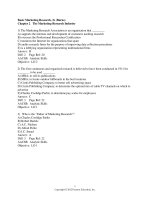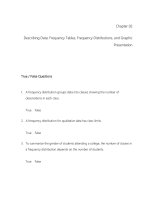Microeconomics theory with applications 8th edition eaton test bank
Bạn đang xem bản rút gọn của tài liệu. Xem và tải ngay bản đầy đủ của tài liệu tại đây (338.11 KB, 15 trang )
MULTIPLE CHOICE. Choose the one alternative that best completes the statement or answers the question.
1) In economics, consumption bundles are:
1) _______
A) utility functions.
B) combinations of goods and services.
C) bags used by retail merchants.
D) preference orderings.
2) Which of the following are necessary assumptions to guarantee that an individual can
consistently rank any set of consumption bundles?
A) completeness and universality
B) transitivity and completeness
C) completeness and non-satiation
D) transitivity and non satiation
2) _______
3) The completeness assumption implies that:
A) indifference curves are smooth.
B) any two points in the x - y space can be ranked.
C) indifference curves are convex.
D) the individual is indifferent between all bundles.
3) _______
4) Which of the following is required for the existence of a utility function?
A) relativity
B) satiation
C) transitivity
4) _______
D) universality
5) Which of the following preference orderings violates the transitivity assumption?
A) Apples are preferred to Oranges, Oranges are preferred to Bananas, Apples are preferred to
Bananas.
B) Oranges are indifferent to Bananas, Bananas are indifferent to Apples, Apples are
indifferent to Oranges.
C) Bananas are indifferent to Oranges, Bananas are preferred to Apples, Apples are preferred
to Bananas.
D) Bananas are preferred to Apples, Apples are indifferent to Oranges, Bananas are preferred
to Oranges.
5) _______
6) Consider four consumption bundles, denoted by A, B, C, and D. Which of the following sets of
preference statements violates the transitivity assumption?
A) D is preferred to B, C is preferred to A, A is preferred to B, B is preferred to C.
B) D is preferred to C, C is preferred to B, B is preferred to A, C is preferred to A.
C) A is preferred to B, B is preferred to C, C is preferred to D, A is preferred to C.
D) A is preferred to C, B is preferred to A.
6) _______
7) The transitivity assumption implies that:
A) indifference curves are smooth.
C) indifference curves are convex.
7) _______
B) indifference curves measure preferences.
D) indifference curves never cross.
8) When Doug is asked whether he would prefer sweetbreads and kumquats or tripe and starfruit,
he replies "I don't know". This is a violation of which assumption?
A) Non-satiation
B) Consistency.
C) Transitivity
D) Completeness
8) _______
9) Which of the following is consistent with the transitivity assumption?
A) If AB) If A>B and A>C then B=C.
C) If A>B and A>C then B>C.
D) If A>B and A=C then B
9) _______
10) The nonsatiation assumption:
A) is a formal way of saying that more is always better.
B) is a well founded empirical truth.
10) ______
C) implies that indifference curves have a positive slope.
D) is saying that individuals always maximize.
11) Nonsatiation implies that consumption bundles:
A) which contain more of one good and less of another are preferred.
B) which are nearer the origin are preferred.
C) which contain more of all goods are preferred.
D) which contain fewer of all goods are preferred.
11) ______
12) Which of the following is a scarce commodity?
A) air
C) stock market advice
12) ______
B) fresh air
D) pollution
13) The nonsatiation assumption says that given any two consumption bundles, if bundle 1 has
more of one good and does not contain less of any other good then:
A) all other bundles are preferred to bundle 1.
B) bundle 1 is preferred to other bundles.
C) bundle 1 is never preferred to others.
D) the individual is indifferent between bundle 1 and all other bundles.
13) ______
14) Scarcity means that:
A) a particular good is difficult to produce.
B) at the current market price there is a shortage of the good.
C) our desire for a good exceeds the amount that is freely available.
D) we are unable to find a particular good in any of the stores we visit.
14) ______
15) Assume that when you get home today, there is a letter in your mailbox from Joe Granburg, the
stock market wizard. He has the latest expert advice for you about purchasing stocks. You
should:
A) wonder why Joe didn't follow his own advice rather than sell the information.
B) immediately phone your broker and follow his advice.
C) only follow his advice if he has good information about the future income streams of those
companies whose stock he recommends you purchase.
D) only follow his advice if it details accurate past trends in stock prices.
15) ______
16) Traffic in the city moves along as well as it does (i.e., few accidents, reasonable speed) because:
A) insurance does not cover all the costs of an accident.
B) drivers are usually concentrating intently on their own welfare.
C) people take others' goals and interests into account.
D) almost all drivers have the same attitude regarding safety and speed.
16) ______
17) Economists assume that an individual's preference orderings include all of the following except:
A) homogeneity.
B) preference or indifference.
C) transitivity.
D) completeness.
17) ______
18) People driving on a four-lane expressway during the rush hour tend to distribute their vehicles
fairly evenly among the four lanes because:
A) their tastes and preferences differ.
B) they choose lanes on a random basis.
C) they all tend to be maximizers.
D) the law of large numbers is operating.
18) ______
19) The fact that I'm willing to eat tater tots when french fries are not available illustrates:
A) inconsistency.
B) diminishing MV.
19) ______
C) maximization.
D) substitution.
20) An indifference curve represents:
A) consumption bundles of equivalent value.
B) average preferences.
C) complete apathy.
D) a complete preference ordering.
20) ______
21) Consider the following preference statements: (7, 9) is preferred to (5, 8); (18, 0) is preferred to (7,
9); and (5, 8) is preferred to (6, 5). If the individual's preferences are consistent, then the
preferences ordering over these four consumption bundles is:
A) (5, 8), (6, 5), (18, 0), (7, 9).
B) (18, 0), (5, 8), (7, 9), (6, 5).
C) (18, 0), (7, 9), (5, 8), (6, 5).
D) (7, 9), (5, 8), (18, 0), (6, 5).
21) ______
22) Indifference curves provide a way to graphically represent:
A) the income level of an individual.
B) the relative price of goods.
C) an individual's preferences.
D) the constraints faced by consumers.
22) ______
23) If Henry decides to give up his social life in order to be more productive at work, an economist
would consider this:
A) hedonistic.
B) inevitable.
C) contrary to maximizing behaviour.
D) one of life's many trade offs.
23) ______
24) Smoking can lead to lung cancer and premature death. Which of the following would an
economist use to explain why people smoke?
A) Smokers exhibit irrational behaviour.
B) Since smoking is addictive, smokers need to smoke.
C) Smokers are not maximizers.
D) Smokers face tradeoffs.
24) ______
25) The basic reason there are so many excellent substitutes for water in almost all Canadian cities is
that:
A) the demand for water is inelastic.
B) there are so many alternative drinks readily available in the marketplace.
C) water is so inexpensive that people use it for many different purposes.
D) the supply of water is limited.
25) ______
26) Which of the following assumptions is not generally applied to an indifference curve?
A) convex
B) transitive
C) smooth
D) diminishing MRS
26) ______
27) The value of a good is determined by:
A) the amount of resources used to produce it.
B) the amount of time it takes to produce it.
C) the maximum amount of goods in the market.
D) the maximum amount that one is willing to sacrifice to get it.
27) ______
28) The continuity assumption implies that:
A) the indifference curves never cross.
C) the indifference curves are convex.
28) ______
29) If Jane's utility function is given by U = xy:
B) the indifference curves are smooth.
D) the indifference curves are continuous.
29) ______
A)
B)
C)
D)
Jane prefers bundle (2,2) to bundle (3,3).
Jane prefers bundle (1,3) to bundle (2,5).
Jane is indifferent between bundle (1,2) and bundle (2,1).
Jane is indifferent between bundle (2,2) and bundle (2,1).
30) Which of the following is a psychological assumption?
A) resource endowment
B) perfect competition
C) self interest
D) common property
30) ______
31) If we consider the bundles A = (5,30) and B = (6,40), then:
A) utility at point A is lower than the utility at point B.
B) B is preferred to A.
C) A is preferred to B.
D) the consumer is indifferent between A and B.
31) ______
32) Along a standard, downward sloping, convex indifference curve the marginal rate of
substitution is:
A) decreasing.
B) constant.
C) positive.
D) increasing.
32) ______
33) The nonsatiation assumption implies that:
A) indifference curves do not cross.
33) ______
C) indifference curves have a positive
slope.
B) indifference curves have a negative
slope.
D) indifference curves are continuous.
34) Which of the following assumptions implies that bundles on indifference curves further from the
origin are preferred to bundles closer to the origin?
A) homogeneity
B) transitivity.
C) non-satiation.
D) completeness.
34) ______
35) Indifference curves are not:
A) continuous.
C) insatiable.
35) ______
B) intersecting.
D) downward sloping.
36) A consumer's set of indifference curves provides:
A) a complete ranking of all possible consumption bundles.
B) a relative ranking of bundles that provide more of all goods.
C) a mechanism to determine market equilibria.
D) a ranking of a set of bundles on an indifference curve.
36) ______
37) Cheryl is always willing to trade 3 cheeseburgers for a bucket of shrimp. Her indifference curves
are:
A) bowed out from the origin
B) straight lines
C) L-shaped
D) bowed in to the origin
37) ______
38) If an individual turns down more spinach at dinner, this individual:
A) is not maximizing.
B) is violating the principle of substitution.
C) is violating the principle of diminishing marginal rate of substitution.
D) is not violating any postulates and could still be maximizing.
38) ______
39) If an indifference curve has a kink, then:
A) the indifference curve is not convex to the origin.
39) ______
B) the marginal rate of substitution is undefined at the kink.
C) the marginal rate of substitution is a meaningless concept.
D) preferences are normal.
40) The slope of an indifference curve reflects:
A) the utility number associated to the utility function.
B) the relative value that a consumer places on one commodity compared to another.
C) the income of a consumer.
D) the relative price of two commodities.
40) ______
41) The rate at which a consumer is willing to exchange one good for another, and maintain a
constant level of satisfaction is:
A) the relative expenditure ratio.
B) the value of marginal product.
C) the marginal rate of substitution.
D) the relative price ratio.
41) ______
42) If the marginal rate of substitution is a constant (5, for example), then indifference curves are not:
A) downward sloping.
B) kinked.
C) smooth.
D) straight lines.
42) ______
43) Tom currently has 100 units of x1 and 50 units of x2, and Jan has 50 units of x1 and 100 units of
43) ______
x2. If Tom's marginal rate of substitution is 10, and Jan's is 1:
A) Pareto-improving trades between Jan and Tom do not exist.
B) Pareto-improving trades exist but cannot be assessed given the above information.
C) Pareto-improving trades involve Jan giving up x2 for x1.
D) Pareto-improving trades involve Tom giving up x1 for x2.
44) If an indifference curve is convex, the marginal rate of substitution is not:
A) minus one times the slope of an indifference curve.
B) a function.
C) the rate at which an individual is willing to trade goods.
D) constant.
44) ______
45) Given the utility function U(x1,x2) = min(x1,x2), the marginal rate of substitution when x1
45) ______
exceeds x2 is:
A) zero.
B) one.
C) undefined.
D) infinite.
46) Which of the following is not a reason that economists use the assumption that indifference
curves are convex?
A) It is measurable.
B) It is convenient.
C) It is reasonable.
D) It directs attention to the relevant part of the curve.
46) ______
47) Given the utility function U(x1,x2) = min(x1,x2), the marginal rate of substitution when x1 equals
47) ______
x2 is:
A) one.
B) infinite.
C) zero.
D) undefined.
48) Given the utility function U(x,y) = x2 + y, which of the following preference statements is true?
A) (2,3) is preferred to (3,2)
B) (2,1) is indifferent to (1,3)
C) (2,1) is preferred to (1,2)
D) (2,1) is indifferent to (1,4)
48) ______
49) Given the following utility function, U(x1,x2) = x1 + x2, which of the following preference
statements is not true?
A) (4, 4) is indifferent to (3, 5)
C) (100, 0) is preferred to (1, 1)
49) ______
B) (1, 4) is indifferent to (2, 2)
D) (1, 9) is preferred to (3, 5)
50) Which of the following is not required for the existence of a utility function?
A) universality
B) completeness
C) nonsatiation
D) continuity
50) ______
51) Tim consumes goods x and y. His utility function is given by U(x,y) = y(x + 5). Which of the
following is true?
A) Tim likes good x but hates good y.
B) Tim prefers bundle (7,3) to bundle (3,7).
C) Tim likes good y but hates good x.
D) Tim prefers bundle (1,2) to bundle (2,1)
51) ______
52) Mary's utility function is U(x,y) = 4x1/2 + y. She has 25 units of x and 12 units of y. If her
consumption of x is reduced to 0, how many units of y would she need in order to be exactly as
well off as before?
A) 32 units
B) 112 units
C) 37 units
D) 48 units
52) ______
53) Benoit's preferences are given by the utility function U(x,y) = 10x + 5y. He consumes 10 units of
good x and 9 units of good y. If he consumes only one unit of x, how many units of y must he
consume in order to be as well off as before?
A) 10
B) 18
C) 27
D) 30
53) ______
54) Jane's utility function is U(x,y) = 2xy. She has 2 units of good x and 4 units of good y. Tim's utility
function is U(x,y) = 5x + 2y. He has 4 units of good x and 1 unit of good y. We can conclude that:
A) Tim prefers Jane's bundle to his own, but Jane prefers her own bundle to Tim's.
B) Jane prefers Tim's bundle to her own, but Tim prefers his own bundle to Jane's.
C) each prefers the other's bundle to their own.
D) each prefers their own bundle to the other's bundle.
54) ______
55) Given the utility function U(x1,x2) = x1 + 2x2, the marginal rate of substitution (MRS) is:
55) ______
A) undefined.
B) zero.
C) equal to 1/2.
D) equal to 2.
56) Anna's preferences can be expressed by the utility function U(x1, x2) = x1 + x2. Which of the
56) ______
following does NOT represent the same preferences?
A) U(x1, x2) = 1000(x1 + x2)
B) U(x1, x2) = x1 + 4x2
C) U(x1, x2) = ln(x1 + x2) + 12
D) U(x1, x2) = (x1 + x2)2
57) If x1 is $20 bills and x2 is $100 bills, then:
A) the utility function is x + 5z.
C) the marginal rate of substitution is 1/5.
57) ______
B) the marginal rate of substitution is 5.
D) indifference curves have many kinks.
58) For the utility function: U = x + y2, the MRS is given by: (calculus required)
A) x/2y.
B) x/2.
C) 1/2y.
58) ______
D) 1/2.
59) Given the following utility function, U(x1,x2) = x1 * x2, which of the following does not represent
the same preference ordering:
A) x1 + x2.
B) x1x2 + 15.
C) x1x2 - 1000.
59) ______
D) (x1x2)2.
60) A representative indifference curve for some individual is c = x1+2x2, where c is a number
gre than or
ater equal
to zero. 60)
Which of
the
followin
g is a
utility
function
for the
individu
al?
A) 2x1 + x2
___
___
B) x1x2
C) x1 - x2
D) 20 + x1 + 2x2
61) Carl has the utility function U(x,y) = 2xy. His indifference curve passing through the bundle (4,3)
must also pass through the point where x is equal to 6 and y is equal to:
A) 24.
B) 2.
C) 10.
D) 12.
61) ______
62) Utility numbers provide:
A) normative information to society.
B) positive information to individuals.
C) precise differences between consumption bundles.
D) positive information to society.
62) ______
63) If an indifference curve is smooth and convex to the origin, then:
A) the indifference curve is said to be normal.
B) the two goods are said to be convex combinations of each other.
C) there is a diminishing marginal rate of substitution.
D) the two goods are said to be concave combinations of each other.
63) ______
64) Utility functions assign a:
A) preference ordering to each individual.
B) unique indifference curve to each number.
C) service truck to each customer request.
D) unique number to each indifference curve.
64) ______
65) If the utility number associated with consumption bundle a is exactly twice the utility number
associated with bundle b, then:
A) bundle a offers as much utility as two of bundle b.
B) bundle a is preferred to bundle b.
C) bundle b is preferred to bundle a.
D) bundle a is twice as desirable as b.
65) ______
66) If the utility number associated with consumption bundle a is exactly half the utility number
associated with bundle b, then:
A) bundle a is preferred to bundle b.
B) bundle b offers as much utility as two of bundle a.
C) bundle b is preferred to bundle a.
D) bundle b is twice as desirable as a.
66) ______
67) If the utility number associated with consumption bundle a is exactly the square root of the
utility number associated with bundle b, then:
A) bundle b is twice as desirable as a.
B) bundle a is preferred to bundle b.
67) ______
C) bundle b offers as much utility as two of bundle a.
D) bundle b is preferred to bundle a.
68) The utility function assigns a utility number that is higher for:
A) more expensive bundles.
B) bundles which the individual is indifferent between.
C) more preferred bundles.
D) less preferred bundles.
68) ______
69) If the indifference curves for some individual are vertical straight lines, the utility function is:
A) U(x,y) = x2 + 5.
B) U(x,y) = xy.
C) U(x,y) = 2xy2 .
D) U(x,y) = x + 2y.
69) ______
70) The utility function U(x,y) = 2x + y is an apt description of the preferences when:
A) x is a left shoe and y is a right shoe.
B) x is pizza and y is cola.
C) x is nickels and y is quarters.
D) x is nickels and y is dimes.
70) ______
71) In Figure 2A, the utility function for some individual is U(x1,x2)=x1x2. An indifference curve for
71) ______
this individual is depicted in:
A) Figure 2A (a).
B) Figure 2A (b).
C) Figure 2A (c).
D) Figure 2A (d).
72) When two goods are perfect substitutes, they will have:
A) indifference curves with a slope equal to +1.
B) indifference curves that are kinked.
C) linear indifference curves.
D) indifference curves that slope upward.
72) ______
73) Horizontal indifference curves imply that:
A) the consumer gets no utility from the Y axis good.
73) ______
B) the goods are perfect complements.
C) the consumer gets no utility from the X axis good.
D) the goods are perfect substitutes.
74) Indifference curves between left shoes and right shoes are:
A) smooth and convex.
B) upward sloping.
C) downward sloping straight lines.
D) L-shaped.
74) ______
75) The utility function U(x1,x2) = min(x1,x2) is an apt description of preferences when:
75) ______
A) x1 is money and x2 is cocaine.
B) x1 is $5 bills and x2 is $5 bills.
C) x1 is a Coke and x2 is a Pepsi.
D) x1 is a left hand glove and x2 is a right hand glove.
76) If x1 is good and x2 is bad, then indifference curves:
A) cannot be linear.
C) have a positive slope.
76) ______
B) are not smooth.
D) have a negative slope.
77) If Al's indifference curves are downward sloping straight lines, then Al's marginal rate of
substitution is:
A) constant.
B) increasing.
C) diminishing.
D) zero.
77) ______
78) In Figure 2A, which of the following curves represents a weakly convex indifference curve?
A) Figure 2A (a)
B) Figure 2A (b)
C) Figure 2A (c)
D) Figure 2A (d)
78) ______
79) In Figure 2A (a):
A) c is preferred to e, d is preferred to e, c is indifferent to d.
B) c is preferred to d, d is preferred to e, e is preferred to c.
79) ______
C) e is preferred to c, e is preferred to d, c is indifferent to d.
D) d is indifferent to c, d is indifferent to e, e is indifferent to c.
80) Suppose Jane enjoys coffee (x) but is allergic to tea (y). Which of the following utility functions
would best represent Tim's utility function for coffee and tea?
A) U(x,y) = x/y
B) U(x,y) = xy
C) U(x,y) = min[x,y]
D) U(x,y) = x + y
80) ______
81) If people regard pollution as a bad thing, then their indifference curves for pollution and income
(P, I) are:
A) convex.
B) kinked.
C) undefined.
D) upward sloping.
81) ______
82) Which of the following statements about indifference curve analysis is false?
A) Indifference curve analysis simplifies the n-good problem for detailed study.
B) Indifference curve analysis is identical to the n-good problem.
C) Indifference curve analysis relies on the same assumptions as the n-good problem.
D) Indifference curve analysis is a special case of the n-good problem.
82) ______
83) Employees demand more more for overtime work because:
A) only the hardworking ones self-select for extra hours.
B) longer hours are tiresome.
C) working extra hours makes them less willing to trade off leisure for income.
D) they are greedy.
83) ______
84) People smooth out consumption over time:
A) because older people require less consumption.
B) to raise their level of utility.
C) because they become wiser as they age.
D) because utility of consumption increases with age.
84) ______
85) Consider the choice between an economic bad, air pollution, and a measure of expenditure on all
other goods, income. The MRS of the indifference curves in this space:
A) is not defined properly.
B) is zero.
C) is positive.
D) is negative.
85) ______
86) The increase in the size of shopping carts for the past three decades is due to:
A) the intention of store owners to sell more.
B) the increase in the income per capita over time.
C) the increase in the opportunity cost of time.
D) the decrease in the cost of producing the carts.
86) ______
87) One of the factors influencing the increase in the size of shopping carts for the past three decades
is:
A) the continued entrance of women into the workforce.
B) the average weight of Canadians increase by 15%.
C) the fact that people eat out less.
D) the increase in the cost of produce storage at home.
87) ______
88) Sheila has preferences represented by the utility function U (x, y) = 8x + 4y. She consumes 12
units of good x and 3 units of good y. If her consumption of good x is lowered to 10, how many
units of y must she have in order to be exactly as well off as before?
88) ______
A) 12 units of good y
C) 5 units of good y
B) 10 units of good y
D) 7 units of good y
89) A vegetarian's indifferent curve in a space defined by hamburgers on the horizontal axis and
broccoli on the vertical axis:
A) cannot be defined.
B) is horizontal.
C) is concave to the origin.
D) is vertical.
89) ______
90) Overtime pay is higher than regular pay because:
A) labour unions have the upper hand in the Canadian economy.
B) employers want to insure quality work after hours.
C) foregone leisure hours in addition to the ones for regular work are valued higher.
D) foregone leisure hours in addition to the ones for regular work are valued lower.
90) ______
SHORT ANSWER. Write the word or phrase that best completes each statement or answers the question.
91) Does a diminishing marginal rate of substitution imply that an individual requires
91) _____________
increasing amounts of one good as he gives up more and more of the other good to
remain at the same utility level?
92) When asked if he wants another beer, Kevin says "no thanks". Is this a violation of the
non-satiation assumption?
92) _____________
93) Compute the MRS for the indifference curve x1 + x2 = c. Is it diminishing?
93) _____________
94) Is the indifference curve between ice cream and garbage positively sloped?
94) _____________
95) Is an indifference curve defined as a set of bundles that a consumer with a given income
can afford, and among which he or she is indifferent?
95) _____________
96) The nonsatiation assumption implies that more is preferred to less. Can two bundles that
contain different amounts of good 1 but the same amount of good 2 be on the same
indifference curve?
96) _____________
97) Sharon's utility function can be expressed as U(x1, x2) = 7x10.25x20.75. How much good
97) _____________
2 is she willing to give up to get one unit of good 1 if she currently has 10 units of good 1
and 30 units of good 2?
98) Explain the difference between ordinal and cardinal utility.
98) _____________
ESSAY. Write your answer in the space provided or on a separate sheet of paper.
99) Consider the following list of statements. Each statement in the list means the same thing as one of the other
statements. Identify the pairs of statements which are equivalent:
a) consumers always prefer to have more of a good;
b) consumers' preferences are complete;
c) consumers' preferences are transitive;
d) every market basket has an indifference curve associated with it;
e) indifference curves are bowed in to the origin;
f) indifference curves are downward sloping;
g) indifference curves do not cross;
h) a diminishing MRS is a characteristic of consumer preferences.
100) Consider the following utility function: U(x,y) = 2y + x1/3
a) What
is the
shape of
an
indifference curve (e.g., smooth, kinked, straight line)? Is the MRS diminishing?
b) How does the MRS change as you move from the indifference curve associated with the utility number 8
to the indifference curve associated with the utility number 27 when x = 2? What about when x = 3?
(Calculus required)
101) Consider the following utility functions:
i) U(x, y) = xy1/2
ii) U(x, y) = 10xy
iii) U(x, y) = 3x + 4y
iv) U(x, y) = 2x + ln(y)
v) U(x, y) = x3
a) Construct an indifference curve for each of these functions.
b) Calculate the MRS for each of these functions. (Calculus required)
102) Consider the following utility function:
U(x, y) = 2x + 3y
a) Draw the indifference curve associated with utility numbers 12 and 24.
b) How does MRS change as we move from one indifference curve to another along the horizontal line y = 2?
What about when y = 3?
103) Jane's utility function is given by: U(x, y) = xy2.
i) Is Jane indifferent between bundles (2,1) and (1,2)?
ii) Suppose Jane consumes 3 units of x and 2 units of y. If Jane increases her consumption of x by 1 unit but
decreases her consumption of y by 1 unit, will she move to a lower indifference curve?
iii) Calculate the MRS when x = 3 and y = 2. (Calculus required)
104) Define the Panglossian dilemma and illustrate it with an example.
1)
2)
3)
4)
5)
6)
7)
8)
9)
10)
11)
12)
13)
14)
15)
16)
17)
18)
19)
20)
21)
22)
23)
24)
25)
26)
27)
28)
29)
30)
31)
32)
33)
34)
35)
36)
37)
38)
39)
40)
41)
42)
43)
44)
45)
46)
47)
48)
49)
50)
51)
B
B
B
C
C
A
D
D
D
A
C
B
B
C
A
B
A
C
D
A
C
C
D
D
C
B
D
D
C
C
B
A
B
C
B
A
B
D
C
B
C
B
D
D
A
A
D
D
B
A
B
52)
53)
54)
55)
56)
57)
58)
59)
60)
61)
62)
63)
64)
65)
66)
67)
68)
69)
70)
71)
72)
73)
74)
75)
76)
77)
78)
79)
80)
81)
82)
83)
84)
85)
86)
87)
88)
89)
90)
91)
92)
93)
94)
95)
96)
97)
A
C
D
C
B
C
C
A
D
B
B
C
D
B
C
D
C
A
D
A
C
C
D
D
C
A
B
C
A
D
B
C
B
C
C
A
D
B
C
Yes. This is the definition of diminishing MRS.
No, it is possible for an individual to reach a satiation point with a particular good, when the marginal utility
reaches zero. However, most economists assume that consumers are never satiated across all goods.
The MRS is equal to 1. For this utility function the MRS is constant.
Yes, because garbage is an "economic bad".
No. The definition of an indifference curve has nothing to do with affordability.
No, except when the two goods are perfect complements.
Sharon's MU of good 1 is (7/4)x1-0.25x20.75 and her MU of good 2 is (21/4)x10.25x2-.075.
Thus, her MRS is 1/3( x2/x1). At her current level, she is willing to give up 1 unit of x2 to get 1 unit of x1.
98) The theory of utility used by economists is an ordinal one, i.e. it reveals only the relative order of consumer
bundles. It does not say anything about the distance between bundles in terms of desirability.
99) e) and h), c) and g), b) and d), a) and f).
100) a) The indifference curves are downward sloping, smooth and bowed in to the origin. They intersect both the
horiz and vertical axes. The MRS is diminishing.
ontal b) MRS = (1/6)x-2/3 doesn't change as you move along a vertical line because does not depend on y.
101) a) i), ii) and iv) indifference curve are smooth and convex; iii) indifference curve is a downwards sloping straight
line; v) indifference curve is a vertical straight line.
b) i) MRS = 3y/x; ii) MRS = y/x; iii) MRS = 3/4; iv) MRS = 2y ; v) MRS = infinity.
102) a) Indifference curves are downward sloping straight lines. When U = 12, the indifference curve crosses the
horizontal line at x=6 and the vertical line at y = 4. When U = 24, the indifference curve crosses the horizontal line at
x = 12 and the vertical line at y = 4..
b) The MRs is constant at every point on the indifference curve and it is equal to 3/2. Therefore, there is no change
in MRS as we move from one point to another along an indifference curve or when we move from one indifference
curve to another. In this case, x and y are perfect substitutes.
103) i) No, Jane prefers (1,2) to (2,1).
ii) Yes, her utility decreases from U = 12 to U = 4 and therefore she moves to a lower indifference curve.
iii) When x = 3 and y = 2, MRS = 1/3.
104) If the economic agents within a model have maximized, it must be that all possible gains from trade and production
have been taken advantage of. This, in turn, means that the economic model in question cannot possibly offer the
economist an insight into how to improve the world with policy prescription. This is the Panglossian dilemma,
named after a character in Voltaire's classic work Candide. The upshot of this is that, even if an economist can
imagine a better world than the one we live in, his or her model already implied that efficiency has been attained.
The world is efficient and "we cannot learn to build a better mousetrap."
